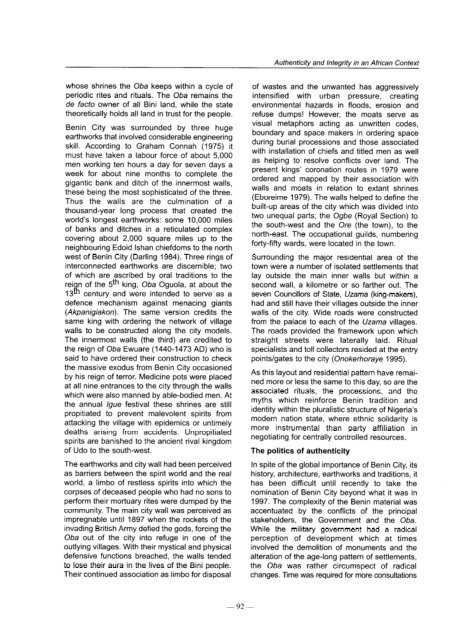Mul - unesdoc - Unesco
Mul - unesdoc - Unesco
Mul - unesdoc - Unesco
You also want an ePaper? Increase the reach of your titles
YUMPU automatically turns print PDFs into web optimized ePapers that Google loves.
whose shrines the Oba keeps within a cycle of<br />
periodic rites and rituals. The Oba remains the<br />
de facto owner of all Bini land, while the state<br />
theoretically holds all land in trust for the people.<br />
Benin City was surrounded by three huge<br />
earthworks that involved considerable engineering<br />
skill. According to Graham Connah (1975) it<br />
must have taken a labour force of about 5,000<br />
men working ten hours a day for seven days a<br />
week for about nine months to complete the<br />
gigantic bank and ditch of the innermost walls,<br />
these being the most sophisticated of the three.<br />
Thus the walls are the culmination of a<br />
thousand-year long process that created the<br />
world’s longest earthworks: some 10,000 miles<br />
of banks and ditches in a reticulated complex<br />
covering about 2,000 square miles up to the<br />
neighbouring Edoid Ishan chiefdoms to the nor-th<br />
west of Benin City (Darling 1984). Three rings of<br />
interconnected earthworks are discernible; two<br />
of which are ascribed by oral traditions to the<br />
rei n of the 5th king, Oba Oguola, at about the<br />
13 il Century and were intended to serve as a<br />
defence mechanism against menacing giants<br />
(Akpanigiakon). The same version credits the<br />
same king with ordering the network of village<br />
walls to be constructed along the city models.<br />
The innermost walls (the third) are credited to<br />
the reign of Oba Ewuare (1440-1473 AD) who is<br />
said to have ordered their construction to check<br />
the massive exodus from Benin City occasioned<br />
by his reign of terror. Medicine pots were placed<br />
at all nine entrantes to the city through the walls<br />
which were also manned by able-bodied men. At<br />
the annual Igue festival these shrines are still<br />
propitiated to prevent malevolent spirits from<br />
attacking the village with epidemics or untimely<br />
deaths arising from accidents. Unpropitiated<br />
spirits are banished to the ancient rival kingdom<br />
of Udo to the south-west.<br />
The earthworks and city wall had been perceived<br />
as barriers between the spirit world and the real<br />
world, a limbo of restless spirits into which the<br />
corpses of deceased people who had no sons to<br />
perform their mortuary rites were dumped by the<br />
community. The main city wall was perceived as<br />
impregnable until 1897 when the rackets of the<br />
invading British Army defied the gods, forcing the<br />
Oba out of the city into refuge in one of the<br />
outlying villages. With their mystical and physical<br />
defensive functions breached, the walls tended<br />
to lose their aura in the lives of the Bini people.<br />
Their continued association as limbo for disposa1<br />
- 92 -<br />
Authenticity and Integrity in an African Context<br />
of wastes and the unwanted has aggressively<br />
intensified with urban pressure, creating<br />
environmental hazards in floods, erosion and<br />
refuse dumps! However, the moats serve as<br />
visual metaphors acting as unwritten codes,<br />
boundary and space makers in ordering space<br />
during burial processions and those associated<br />
with installation of chiefs and titled men as well<br />
as helping to resolve conflicts over land. The<br />
present kings’ coronation routes in 1979 were<br />
ordered and mapped by their association with<br />
walls and moats in relation to extant shrines<br />
(Eboreime 1979). The walls helped to define the<br />
built-up areas of the city which was divided into<br />
two unequal parts; the Ogbe (Royal Section) to<br />
the south-west and the Ore (the town), to the<br />
north-east. The occupational guilds, numbering<br />
forty-fifty wards, were located in the town.<br />
Surrounding the major residential area of the<br />
town were a number of isolated settlements that<br />
lay outside the main inner walls but within a<br />
second wall, a kilometre or SO farther out. The<br />
seven Councillors of State, Uzama (king-makers),<br />
had and still have their villages outside the inner<br />
walls of the City. Wide roads were constructed<br />
from the palace to each of the Uzama villages.<br />
The roads provided the framework upon which<br />
straight streets were laterally laid. Ritual<br />
specialists and toll collectors resided at the entry<br />
points/gates to the city (Onokerhoraye 1995).<br />
As this layout and residential pattern have remai-<br />
ned more or less the same to this day, SO are the<br />
associated rituals, the processions, and the<br />
myths which reinforce Benin tradition and<br />
identity within the pluralistic structure of Nigeria’s<br />
modern nation state, where ethnie solidarity is<br />
more instrumental than party affiliation in<br />
negotiating for centrally controlled resources.<br />
The politics of authenticity<br />
In spite of the global importance of Benin City, its<br />
history, architecture, earthworks and traditions, it<br />
has been difficult until recently to take the<br />
nomination of Benin City beyond what it was in<br />
1997. The complexity of the Benin material was<br />
accentuated by the conflicts of the principal<br />
stakeholders, the Government and the Oba.<br />
While the military government had a radical<br />
perception of development which at times<br />
involved the demolition of monuments and the<br />
alteration of the age-long pattern of settlements,<br />
the Oba was rather circumspect of radical<br />
changes. Time was required for more consultations

















